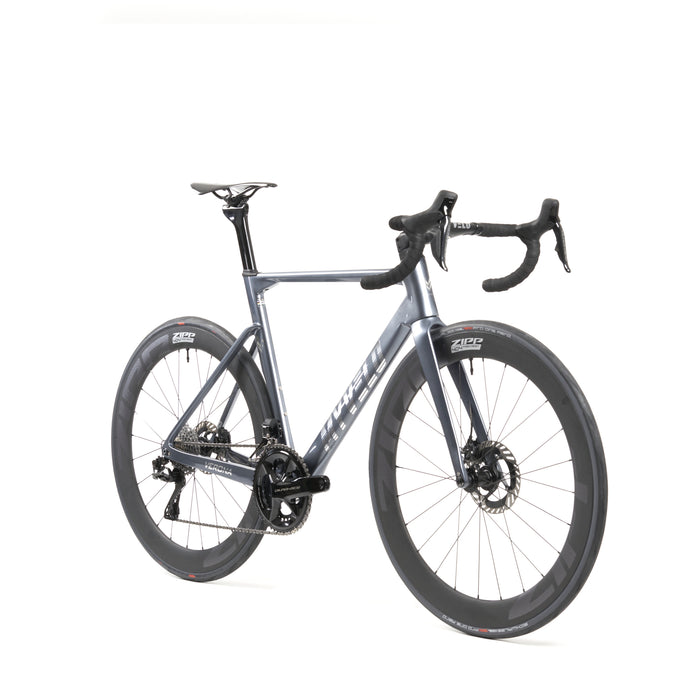
Verona road bike
incl. FREE shipping & free returns

Whether long climbs in the Alps or short, challenging hills in the low mountain ranges – riding in mountainous terrain places special demands on technique, strength and endurance.
Von Fabian Huber |
3 minutes read time

Efficient climbing and descending saves energy, protects muscles, and improves overall performance. In this article, you'll learn which techniques and training methods will make you a better climber and downhill skier.
When climbing, a stable position on the racing bike is crucial.
Riding while sitting: A steady cadence of 70–90 revolutions per minute helps to avoid overloading the muscles.
Pedaling out of the saddle: This technique is especially useful on steep climbs or for short-term recovery of the seat muscles. Body weight should be used in a controlled manner to avoid wasting too much energy.
Center of gravity forward: The upper body remains calm, hands loose on the handlebars so as not to use up unnecessary strength in the arms.
Modern gear systems offer a wide range of gear ratios. Choosing the right one helps maintain a consistent cadence.
Downshift early: If you only shift when the terrain gets steeper, you risk a sudden drop in power.
Small gears for long climbs: A compact crank (50/34) or a cassette with a larger sprocket (e.g. 11-32) can make riding more comfortable.
Deep, conscious breathing improves oxygen uptake and can help maintain consistent performance throughout the climb.
Consistent intensity: Starting off too quickly often leads to a lack of energy later on. Watt-controlled training or monitoring your heart rate helps avoid overexertion.
Divide climbs into sections: If you divide the mountain into several sections and set stage goals, you will stay mentally stronger.
Go low: A low position on the bike improves aerodynamics and stability. Your hands should be on the drops for more control.
Shift your body's center of gravity backwards: This prevents the front wheel from being overloaded and improves control.
Knee slightly outwards: This stabilizes the bike in the curve.
Use the front brake sparingly: Approximately 70% of the braking force comes from the front brake. Even pressure distribution prevents wheels from locking up.
Approach curves at an appropriate speed: brake before the curve, not in the curve!
Eye tracking: Look where you want to go.
Approaching corners optimally: Turn in on the outside, pull in, and then turn out again at the exit of the corner.
High-intensity repetitions: 4–8 minutes of hard work, then recovery.
Vary: Sometimes ride sitting down, sometimes riding in a rocking position.
Longer climbs at a low cadence (50–60 rpm) strengthen the muscles for long climbs.
Ergometers or roller training with simulated climbs also help on flat land.
Practice descents specifically: Ride the same routes over and over again to gain confidence.
Simulate obstacles and tight turns: Develop a confident feel for the bike.
Anyone who wants to ride efficiently in the mountains needs to optimize technique, strategy, and training both uphill and downhill. Good climbing technique saves energy, while safe descents build confidence. With the right training and consistent practice, you'll be more confident and faster on every route.

Radfahren steht für Freiheit, Ausdauer und mentale Stärke. Doch gerade Frauen kennen auch die Schattenseite des Sports – wenn der Intimbereich nach langen Touren schmerzt, taub wird oder einfach nur brennt. Themen wie Reibung, Druckstellen oder Schwellungen sind tabu, aber sie betreffen viele. Zeit also, ehrlich darüber zu sprechen, wie Radfahren den weiblichen Intimbereich beeinflusst – und was wirklich hilft.

Gravelbikes sind in den letzten Jahren zu echten Allroundern auf dem Fahrradmarkt geworden. Sie kombinieren die Sportlichkeit eines Rennrads mit der Robustheit eines Mountainbikes und sind ideal für alle, die sowohl auf Asphalt als auch auf Schotterwegen unterwegs sein wollen. Doch gerade Einsteiger stellen sich oft die Frage: Bekommt man ein gutes, modernes Gravelbike schon für unter 1000 Euro? Die Antwort lautet: Ja – wenn man weiß, worauf es ankommt.

Wer viel Rennrad fährt, kennt das Gefühl: Anfangs ist alles wunderbar – der Wind pfeift, die Beine laufen, die Strecke ist dein Element. Doch nach einer Stunde meldet sich dein Hintern. Erst leicht, dann stechend, schließlich so brennend, dass jeder Tritt zur Qual wird. Willkommen im Club: Satteldruck und gereizte Haut gehören zu den häufigsten Beschwerden unter Radfahrer*innen – und kaum jemand spricht offen darüber.
Zeit, das Tabu zu brechen.